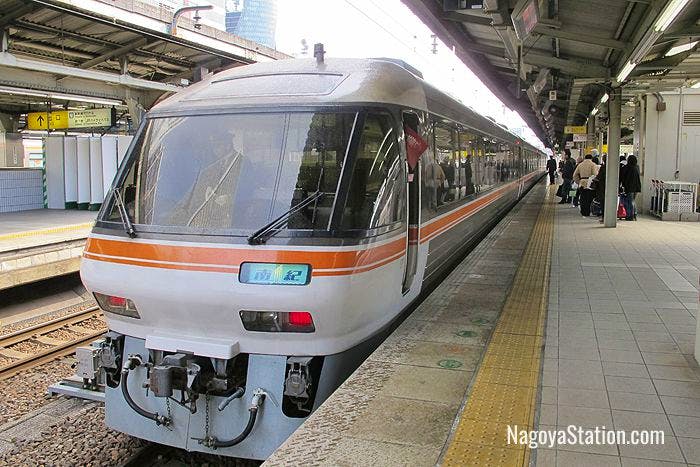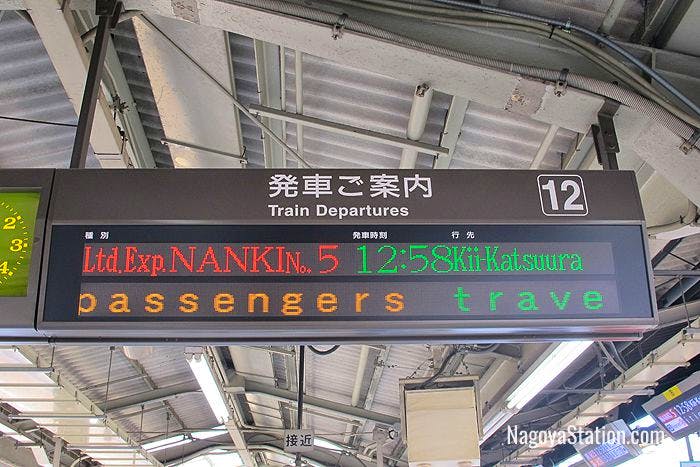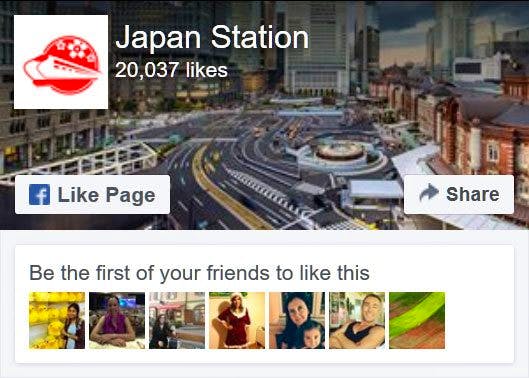The Nanki is a limited express service which runs between Nagoya Station and two destinations in Wakayama Prefecture: Shingu and Kii-Katsuura. This train is notable for passing through several important locations on the scenic Kii peninsula, and is also called the “Wide View Nanki” because its large windows enable passengers to fully enjoy the passing scenery.

The Limited Express Nanki at Platform 12, Nagoya Station
The Nanki is operated by JR Central, but for part of its journey it runs along the private Ise Line. For this reason it is not completely free for Japan Rail Pass holders. If you have a Japan Rail Pass you will have to pay a small surcharge to Ise Railway, but including the passenger ticket of 510 yen, and the limited express fee of 310 yen, the total charge is still only 820 yen. At Nagoya Station this train departs from Platform 12.
Table of Contents
Key Destinations
The Nanki makes limited stops at the following stations.
Nagoya – Kuwana – Yokkaichi – Suzuka – Tsu – Matsusaka – Taki – Misedani – Kii-Nagashima – Owase – Kumanoshi – Shingu – Kii-Katsuura
Between Yokkaichi and Tsu the Nanki runs along the private Ise Line. Below are listed the key destinations and transfer points. Example travel times and train fares for unreserved seats are given from Nagoya Station. To reserve a seat usually costs around 520 yen extra but this can go up by 200 yen or down by 200 yen according to the travel period.

Departure information for Nanki #5 at Platform 12, Nagoya Station
Kuwana Station
Kuwana attractions include the Meiji era Rokkaen house and gardens which were designed by the British architect, Josiah Conder, and Nagashima Spa Land which is a popular amusement park with roller coasters, a Ferris Wheel, and a water park. Transfers can be made here to the Kintetsu Nagoya Line, the private Yoro Line, and the private Sangi Hokusei Line.
Train fare: 670 yen
Train time: 20 minutes
Yokkaichi Station
Yokkaichi is a major port city in Mie Prefecture. It is best known for the Dai-Yokkaichi Festival held every August, which features parades of giant mechanical dolls, dancing and taiko drumming. From the JR Yokkaichi Station you can transfer by bus to the Kintetsu Yokkaichi Station for the Kintetsu Nagoya Line, the Kintetsu Yunoyama Line, and the Yokkaichi Asunarou Railway Utsube Line.
Train fare: 1,120 yen
Train time: 32 minutes
Tsu Station
Tsu is the capital city of Mie Prefecture. The city’s attractions include Kitabake Shrine which dates from 1643, Mie Prefectural Museum, Mie Prefectural Art Museum, and Tsu Castle. Tsu Castle was originally built in 1558, but the current tower is a reconstruction built in 1958. Transfers can be made here to JR Central’s Kisei Line and the Kintetsu Nagoya Line.
Train fare: 2,230 yen
Train time: 55 minutes
Matsusaka Station
Matsusaka is a historical city with many preserved traditional buildings dating from the Edo era. The ruins of Matsusaka Castle (built in 1588) are not complete but the walls are still impressive. Within the castle grounds are two museums, the History and Folklore Museum, and a museum dedicated to the 18th century classical Japanese scholar Motoori Norinaga. Close by the castle grounds are the Castle Guard Residences: the preserved homes of the samurai who guarded the castle. One of these buildings is open to the public.
Matsusaka is also famous for indigo blue cotton, traditional green tea and for Matsusaka beef which is believed to be especially tender because the cows are massaged and fed with beer. Transfers can be made here to JR Central’s Kisei Line and Meisho Line, and to the Kintetsu Yamada Line.
Train fare: 3,140 yen
Train time: 1 hour and 10 minutes
Owase Station
Owase is a small port town in the south of Mie Prefecture. The UNESCO World Heritage hiking trail, the Kumano Kodo, passes close to Owase, and the Kumano Kodo Center is also located here. This center has exhibitions detailing the history of the ancient pilgrimage route. Owase Shrine is notable for having a massive pair of sacred camphor trees which are presumed to be around 1,000 years old. They are called the “married couple trees” and people pray here for romantic fortune or for a happy marriage.
Train fare: 5,570 yen
Train time: 2 hours and 40 minutes
Kumanoshi Station
Kumanoshi Station serves the city of Kumano. This city is known for its beautiful beaches and rock formations, the scenic Matsumoto-toge Pass hiking trail, and the Hana-no-Iwaya Shrine which is believed to be one of the oldest shrines in Japan.
Train fare: 6,330 yen
Train time: 3 hours and 8 minutes
Shingu Station
Shingu is a city in Wakayama Prefecture which is best known for Kumano Hatayama Grand Shrine, which is one of the Three Grand Shrines of Kumano and a UNESCO World Heritage Site. Another UNESCO World Heritage Site is Kamikura Shrine on Mount Kamikura which commands a spectacular view over the city.
Train fare: 6,870 yen
Train time: 3 hours and 29 minutes
Kii-Katsuura Station
Kii-Katsuura Station serves the town of Nachikatsuura in Wakayama Prefecture. This is the home of Kumano Nachi Taisha, which is another one of the Three Grand Shrines of Kumano and a UNESCO World Heritage Site. Not far from the shrine is Nachi no Taki, which at 133 meters is the tallest waterfall in Japan.
Train fare: 7,200 yen
Train time: 3 hours and 51 minutes
Timetables
The Limited Express Nanki runs three round trip services that take in Nagoya, Shingu and Kii-Katsuura, and one round trip service that runs between Nagoya and Shingu only.
| Service | Nagoya | Shingu | Kii-Katsuura |
| Nanki #1 | 8.05 | 11.34 | 11.56 |
| Nanki #3 | 10.01 | 13.37 | 13.56 |
| Nanki #5 | 12.58 | 16.24 | 16.42 |
| Nanki #7 | 19.47 | 23.14 | – |
| Service | Kii-Katsuura | Shingu | Nagoya |
| Nanki #2 | – | 6.20 | 9.41 |
| Nanki #4 | 8.55 | 9.12 | 12.41 |
| Nanki #6 | 12.24 | 12.41 | 16.10 |
| Nanki #8 | 17.11 | 17.29 | 20.49 |
To look up train times, fares, and connections quickly and easily use online English language route finders like Jorudan or Hyperdia.
Article and original photos by Michael Lambe. All rights reserved.
